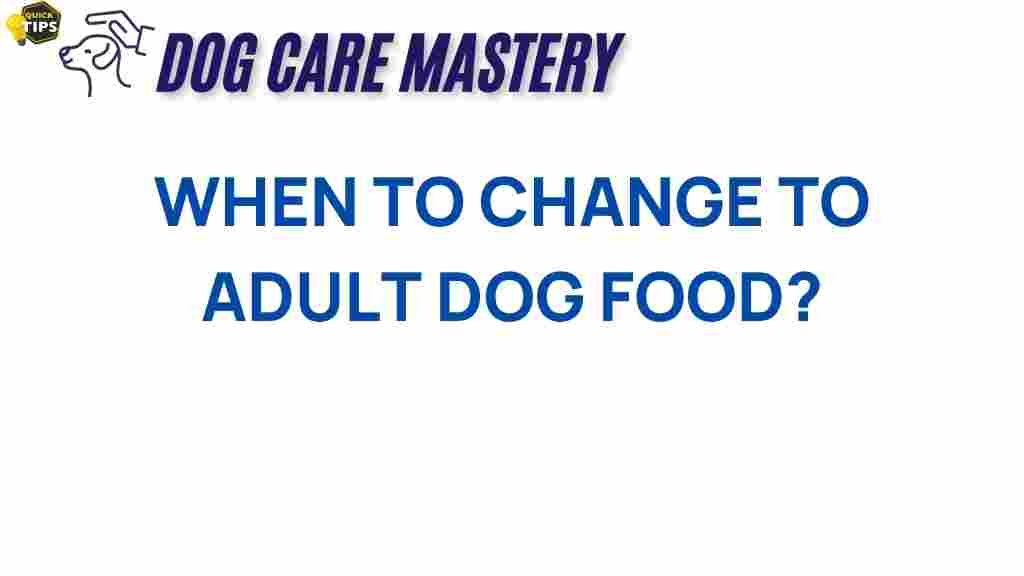Unlocking the Mystery: When Should You Switch to Adult Dog Food?
As a responsible pet owner, you want to ensure your furry friend is getting the best nutrition possible. One of the most common questions among dog owners is, “When should I switch to adult dog food?” This transition is crucial for your dog’s health and well-being. Understanding the right time to make this switch can ensure that your dog receives the appropriate nutrients for their life stage. In this article, we will explore the factors that influence this decision, the signs that indicate it’s time, and tips for making the transition smoothly.
Understanding Dog Life Stages
Before diving into when to switch to adult dog food, it’s essential to understand the various life stages of dogs. Generally, a dog’s life can be categorized into three main stages:
- Puppy Stage: From birth to about 12 months, depending on the breed.
- Adult Stage: From 1 year to about 7 years, though this can vary based on size and breed.
- Senior Stage: Typically from 7-10 years and beyond, again depending on the breed.
Puppies require a diet specifically formulated for their growth and development, while adult dogs need a balanced diet that maintains their health and energy levels. Understanding these stages will help you determine the right time to switch to adult dog food.
Factors Influencing the Switch to Adult Dog Food
Several factors will influence when you should switch your dog from puppy food to adult dog food:
- Age: Most dogs can transition to adult food between 12 to 18 months.
- Breed Size: Smaller breeds may mature faster and can switch to adult food sooner than larger breeds. For example:
- Small breeds (e.g., Chihuahuas) may switch at around 9-12 months.
- Medium breeds (e.g., Beagles) usually transition at 12-15 months.
- Large breeds (e.g., Golden Retrievers) may need to stay on puppy food until 18-24 months.
- Health Status: Dogs with specific health issues may require special diets and a different timeline for transitioning.
Signs Your Dog is Ready for Adult Dog Food
There are several indicators that can help you determine if your dog is ready to make the switch:
- Growth Plate Closure: If your puppy’s growth plates have closed, it might be time for adult dog food. This typically happens around 12-18 months.
- Weight Management: If your puppy is gaining weight rapidly and is nearing the upper limit of its ideal weight, it may be time to switch.
- Energy Levels: Adult dogs often have different energy needs than puppies. If your dog seems to have stabilized in its energy levels, consider making the switch.
- Dental Development: As puppies grow, their adult teeth come in, and they may be ready for the harder kibble found in adult dog food.
How to Transition to Adult Dog Food: A Step-by-Step Process
Once you’ve determined that your dog is ready to switch to adult dog food, it’s essential to do so gradually to avoid gastrointestinal upset. Follow these steps for a smooth transition:
- Choose the Right Adult Dog Food: Select a high-quality adult dog food that meets your dog’s specific nutritional needs. Look for options that are appropriate for your dog’s breed, size, and any health issues.
- Start Slowly: Begin by mixing a small amount of adult dog food with their puppy food. A typical starting ratio is 25% adult food and 75% puppy food.
- Gradually Increase the Ratio: Over the course of 7-10 days, slowly increase the proportion of adult dog food while decreasing the puppy food. Adjust based on your dog’s tolerance.
- Monitor Your Dog: Keep an eye on your dog during the transition. Look for any signs of digestive upset, such as vomiting or diarrhea. If issues arise, slow down the transition process.
- Consult Your Veterinarian: If you have concerns about your dog’s health or dietary needs, consult your veterinarian for personalized advice.
Troubleshooting Common Issues During the Transition
While transitioning to adult dog food, you may encounter some challenges. Here are some common issues and how to address them:
- Digestive Upset: If your dog experiences diarrhea or vomiting, revert to the previous food for a few days until their stomach settles, then resume the transition more slowly.
- Refusal to Eat: If your dog refuses to eat the new food, try mixing in a small amount of wet food or adding a tasty topper to entice them.
- Weight Gain: Monitor your dog’s weight closely during the transition. If they gain weight rapidly, consider reducing the portion sizes.
- Allergic Reactions: Watch for signs of allergies, such as itching or skin irritations. If these occur, consult your veterinarian and consider a different brand or formula.
Conclusion
Deciding when to switch to adult dog food is an essential aspect of responsible pet ownership. By considering your dog’s age, breed, and health status, you can make an informed decision that supports their ongoing health and happiness. Remember to transition gradually and monitor your dog for any signs of distress. If you have any concerns or questions, don’t hesitate to consult your veterinarian for advice tailored to your dog’s needs.
For more information on dog nutrition, check out this informative guide that covers various dog food options, including how to select the right one for your pet. Additionally, consider visiting this resource for more tips on caring for your adult dog.
This article is in the category Nutrition and created by dogcaremastery Team
